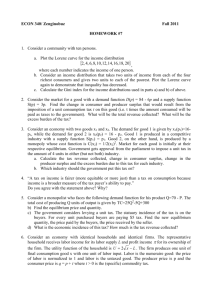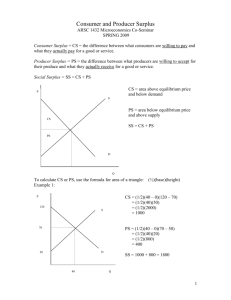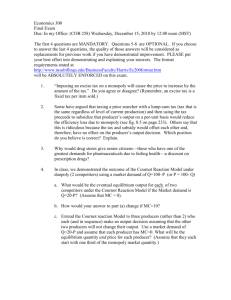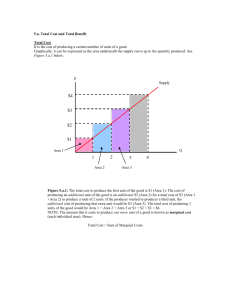The Effect of Taxes on Equilibrium Example 1
advertisement
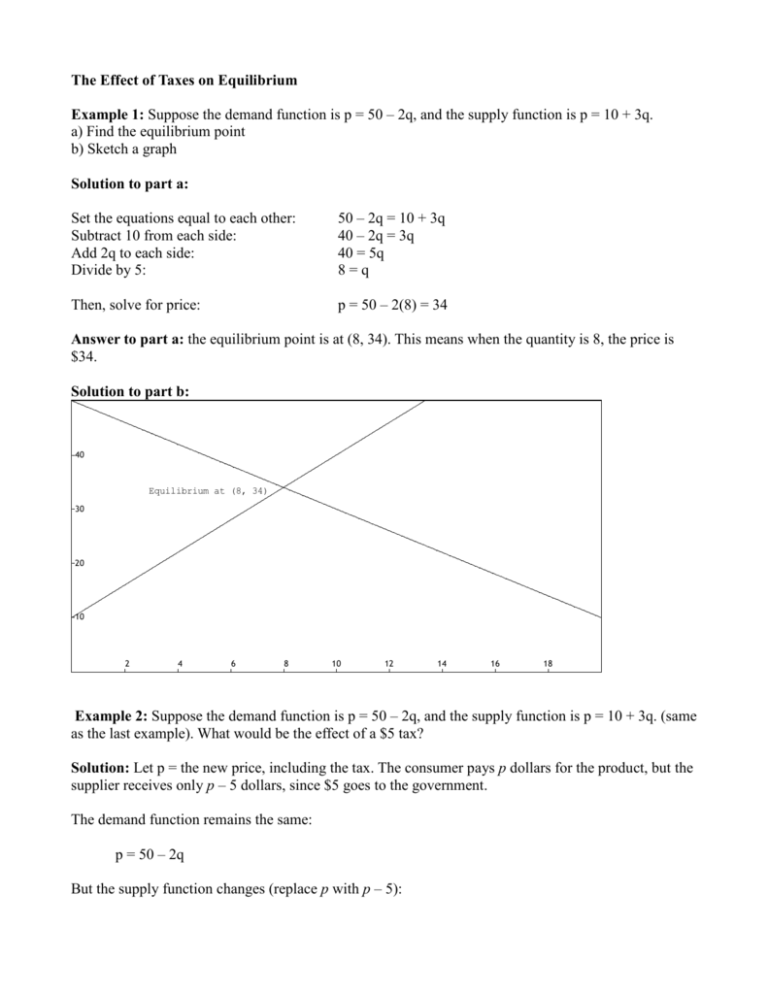
The Effect of Taxes on Equilibrium Example 1: Suppose the demand function is p = 50 – 2q, and the supply function is p = 10 + 3q. a) Find the equilibrium point b) Sketch a graph Solution to part a: Set the equations equal to each other: Subtract 10 from each side: Add 2q to each side: Divide by 5: 50 – 2q = 10 + 3q 40 – 2q = 3q 40 = 5q 8=q Then, solve for price: p = 50 – 2(8) = 34 Answer to part a: the equilibrium point is at (8, 34). This means when the quantity is 8, the price is $34. Solution to part b: 40 Equilibrium at (8, 34) 30 20 10 2 4 6 8 10 12 14 16 18 Example 2: Suppose the demand function is p = 50 – 2q, and the supply function is p = 10 + 3q. (same as the last example). What would be the effect of a $5 tax? Solution: Let p = the new price, including the tax. The consumer pays p dollars for the product, but the supplier receives only p – 5 dollars, since $5 goes to the government. The demand function remains the same: p = 50 – 2q But the supply function changes (replace p with p – 5): p – 5 = 10 + 3q We can algebraically re-arrange, by putting the 5 on the other side: p = 15 + 3q The ultimate result is the supply curve moves up by $5. 40 supply curve with $5 tax 30 original supply curve 20 10 2 4 6 8 10 12 14 16 18 This is a general concept in economics. The effect of any tax on a product is to move the supply curve upwards. Here is one way to think about this: Let’s use the point (2, 16) from the original supply curve as an example. Imagine a producer saying, “If the price is $16, I am willing to produce 2 units” Now, with a $5 tax, the supply curve moves up $5, so imagine the producer saying “I used to be willing to produce 2 items if the selling price was $16. But now, the price will have to be $21 for me to produce 2 items. I still only get $16 and $5 goes to the government.” Example 3: With a $5 tax, what is the new equilibrium point? Solution: Set the demand and supply functions equal to each other (but add $5 to the supply function) 50 – 2q = 15 +3q 35 – 2q = 3q 35 = 5q 7=q The new price will be: 50 – 2(7) = $36. Answer: The new equilibrium point will be (7, 36) Notice that the original price was $34, and it went up to $36 as a result of the tax. This is a $2 increase, but the tax was $5. This means the producer pays $3 of the tax, while passing $2 of the tax off to the consumer. The consumer pays $36. Out of this, $5 is the tax and the producer keeps $31. Example 4: How much revenue does the government collect as a result of this $5 tax? Solution: The government collects $5 per unit, and the quantity at the new equilibrium point is q = 7. Therefore the tax revenue is: Price × quantity = (5 dollars per unit)(7 units) = $35. Answer: the government will collect $35 in revenue. The tax revenue can be represented in terms of area, using the diagram below: The height of the rectangle is the tax (in this case, $5), and the width is q (in this case, 7). The area of the rectangle is $35. Notice that the producer surplus is less, because it is based on the price the supplier receives (in this case, p – 5). Example 5: Compute the producer surplus. Solution: We use the same formula as before: q* Pr oducer Surplus = revenue − ∫ S (q )dq 0 Except we need to make some adjustments to account for the tax. First, compute the revenue. However, it is not simply price times quantity, because the producer receives p – 5 dollars. Revenue = quantity × (p- 5) = 7*31 = $217 To compute the area under the curve, use the q based on the tax, but use the original supply function (without the tax), because the producer does not receive the tax: Area under the supply curve = ∫ q* 0 S (q )dq ∫ = 7 0 (10 + 3q ) dq 7 3q 2 = 10q + 2 0 =(70 + 73.5) − 0 = 143.5 Finally, subtract: Revenue – area under the curve = 217 – 143.5 = 73.5 Answer: The producer surplus is $73.5 Example 6: Suppose a demand function is p = 400q-0.5, and the supply function is p = 2q0.8. What is the equilibrium point if there is a 9% sales tax on the product? Solution: Just like the previous example, the demand function stays the same, while the supply function moves upwards. How far does it move up? It moves up by 9%. This effectively means to multiply the supply function by 1.09. New supply function: (1.09)(2q0.8) = 2.18q0.8 Set the equations equal to each other: 400q-0.5 = 2.18q0.8 Divide both sides by 2.18: 183.4862q-0.5 = q0.8 Divide both sides by q-0.5: 183.4862 = q1.3 Raise both sides to the 1/1/3 power: (183.4862)1/1.3 = q Solution: 55.11 = q Plug 55.11 in for q in either the supply or demand function: p = $53.88 Answer: The equilibrium point is (55.11, 53.88) Example 7: What is the tax revenue, and what is the revenue for the producer? Solution: First, we have to figure out the amount of the tax. Notice that we cannot simply multiply 53.88 by .09 to find the tax, because $53.88 is the price with the tax already included. We have to multiply the original price (which is unknown) by 0.09. In this situation, we have to use a method called back-taxing, to figure out the tax: Since the tax is 9%, normally we multiply the original price by 1.09 to figure out the new price. However, in this case, we don’t know the original price. Let’s call it p0. Set up the equation: (1.09)p0 = 53.88 Divide by 1.09: p0 = 49.43 Then, subtract to find the tax: 53.88 – 49.43 = 4.45 Now, we can compute the revenues: Tax revenue = price × quantity = (4.45)(55.11) = $245.24 Producer’s revenue = price × quantity = (49.43)(55.11) = $2,724.09 Answer: the tax revenue is $245.24, and the producer’s revenue is $2,724.09 Practice Problems For each pair of functions, find the following: a) the equilibrium point without the tax b) the equilibrium point with the tax c) the tax revenue d) the producers’ revenue e) the producers’ surplus f) Use Graphmatica or Excel to graph the demand function and both supply functions. Show the consumers’ surplus, producers’ surplus, tax revenue, and both equilibrium points. 1. D(q) = -0.07q + 82, S(q) = 0.09q + 14, $3 tax 2. D(q) = -0.03q + 64, S(q) = 0.05q + 21, $4 tax 3. D(q) = 500q-0.7 , S(q) = 4q0.2, 6% tax 4. D(q) = 300q-0.6 , S(q) = 4q0.3, 7% tax Answers 1a) (425, $52.25). b) (406.25, $53.56). c) $1218 d) $20,527.36. e) $7,425.74 (for parts c, d and e, quantity is rounded to the nearest whole number). 3a) (213.75, $11.70) b) (200.35, $12.24) c) price before tax: $11.55, tax: $0.69, tax revenue: $138.00 d) $2310 e) $4386.40 (for parts c, d and e, quantity is rounded to the nearest whole number).


